UFO conspiracy theories are a subset of conspiracy theories which argue that various governments and politicians globally, in particular the United States government, are suppressing evidence that unidentified flying objects are controlled by a non-human intelligence or built using alien technology. Such conspiracy theories usually argue that Earth governments are in communication or cooperation with extraterrestrial visitors despite public disclaimers, and further that some of these theories claim that the governments are explicitly allowing alien abduction.

Raymond Alfred Palmer was an American author and magazine editor. Influential in the first wave of science fiction fandom, his first fiction stories were published in 1935.
Dulce Base is the subject of a conspiracy theory claiming that a jointly-operated human and alien underground facility exists under Archuleta Mesa on the Colorado–New Mexico border near the town of Dulce, New Mexico, in the United States. Claims of alien activity there first arose from Albuquerque businessman Paul Bennewitz.
Kenneth Albert Arnold was an American aviator, businessman, and politician.
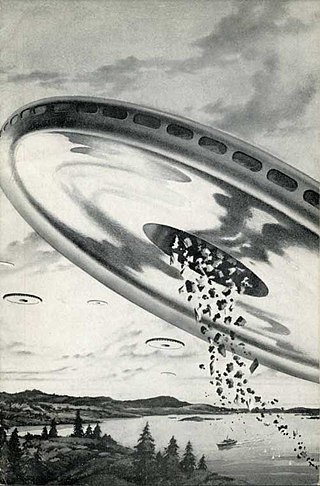
The Maury Island incident refers to claims made by Fred Crisman and Harold Dahl of falling debris and threats by men in black following sightings of unidentified flying objects in the sky over Maury Island, Washington, United States. The pair claimed that the events had occurred on June 21, 1947. The incident is widely regarded as a hoax, even by believers of flying saucers and UFOs.

The Flying Saucers Are Real, by Donald Keyhoe, was a book that investigated reports of UFOs by United States Air Force fighters, personnel, and other aircraft, between 1947 and 1950.
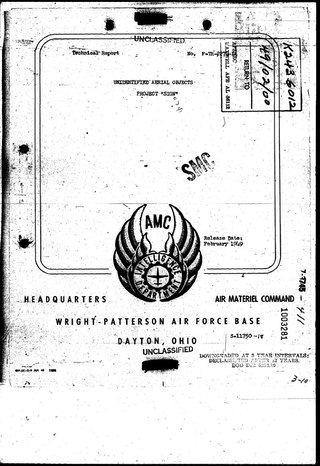
Project Sign or Project Saucer was an official U.S. government study of unidentified flying objects (UFOs) undertaken by the United States Air Force (USAF) and active for most of 1948. It was the precursor to Project Grudge.

In ufology, conspiracy theory, science fiction, and comic book stories, claims or stories have circulated linking UFOs to Nazi Germany. The German UFO theories describe supposedly successful attempts to develop advanced aircraft or spacecraft prior to and during World War II, further asserting the post-war survival of these craft in secret underground bases in Antarctica, South America, or the United States, along with their creators.

From July 12 to 29, 1952, a series of unidentified flying object (UFO) sightings were reported in Washington, D.C., and later became known as the Washington flap, the Washington National Airport Sightings, or the Invasion of Washington. The most publicized sightings took place on consecutive weekends, July 19–20 and July 26–27. UFO historian Curtis Peebles called the incident "the climax of the 1952 (UFO) flap"—"Never before or after did Project Blue Book and the Air Force undergo such a tidal wave of (UFO) reports."

A flying saucer is a purported disc-shaped UFO. In science fiction, reported UFO sightings, and UFO conspiracy theories, they are typically piloted by nonhuman beings. The term "flying saucer" or "flying disc" can be used generically for a mysterious flying object. The term was coined in 1947 but has gradually been supplanted since 1952 by the United States Air Force term unidentified flying object (UFO), the downside of which being that, according to the term, absolutely anything can be a UFO. Early reported sightings of unknown "flying saucers" usually described them as silver or metallic, sometimes reported as covered with navigation lights or surrounded with a glowing light, hovering or moving rapidly, either alone or in tight formations with other similar craft, and exhibiting high maneuverability.

The Kenneth Arnold UFO sighting occurred on June 24, 1947, when private pilot Kenneth Arnold claimed that he saw a string of nine, shiny unidentified flying objects flying past Mount Rainier at speeds that Arnold estimated at a minimum of 1,200 miles an hour (1,932 km/h). This was the first post-World War II sighting in the United States that garnered nationwide news coverage and is credited with being the first of the modern era of UFO sightings, including numerous reported sightings over the next two to three weeks. Arnold's description of the objects also led to the press quickly coining the terms flying saucer and flying disc as popular descriptive terms for UFOs.
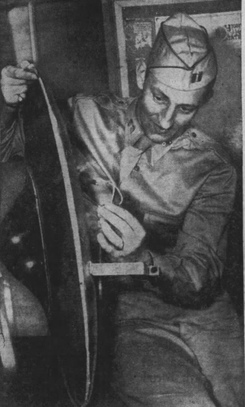
The Twin Falls saucer hoax was a hoaxed flying disc discovered in Twin Falls, Idaho, United States, on July 11, 1947. Amid a nationwide wave of alleged "flying disc" sightings, residents of Twin Falls reported recovering a 30 in (76 cm) "disc". FBI and Army officials took possession of the disc and quickly proclaimed the object to be a hoax. Press reported that local teenagers admitted to perpetrating the hoax.

They Knew Too Much About Flying Saucers is a 1956 book by paranormal author Gray Barker. It was the first book to allege that "Men in Black" were covering up the existence of flying saucers.

The Flight 105 UFO sighting occurred on July 4, 1947, when three crew members aboard a United Airlines flight reported seeing multiple unidentified flying objects in the skies over the Pacific Northwest. The incident was among at least 800 similar sightings in the United States within a few weeks in the summer of 1947, but the first report by professional pilots. The U.S. military ultimately attributed what the crew members saw to "ordinary aircraft, balloons, birds, or pure illusion".
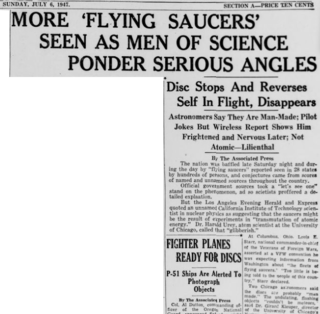
The 1947 flying disc craze was a rash of unidentified flying object reports in the United States that were publicized during the summer of 1947. The craze began on June 24, when media nationwide reported civilian pilot Kenneth Arnold's story of witnessing disc-shaped objects which headline writers dubbed "Flying Saucers". Such reports quickly spread throughout the United States; historians would later chronicle at least 800 "copycat" reports in subsequent weeks, while other sources estimate the reports may have numbered in the thousands.

The Rhodes UFO photographs, sometimes called the shoe-heel UFO photographs, purport to show a disc-like object flying above Phoenix, Arizona, United States. The two photographs were reportedly taken on July 7, 1947, by amateur astronomer and inventor William Albert Rhodes. They were printed in The Arizona Republic newspaper on July 9, along with Rhodes's account of his sighting of the object. Published near the end of the 1947 flying disc craze, the photographs were among the first showing an unidentified flying object. They continue to be discussed in the media into the 21st century.

The Flying Saucer Conspiracy is a 1955 book authored by early UFO researcher Donald Keyhoe. The book pointedly accused elements of United States government of engaging in a conspiracy to cover up knowledge of flying saucers. Keyhoe claims the existence of a "silence group" of orchestrating this conspiracy.

The Report on Unidentified Flying Objects is a 1956 book by then-retired Air Force UFO investigator Edward J. Ruppelt, detailing his experience running Project Bluebook. The book was noted for its suggestion that a few UFO sightings might be linked to spikes of atomic radiation. Contemporary media summarized four topics discussed in the book:

"Have We Visitors From Space?" was an article on Flying Saucers by H. B. Darrach Jr. and Robert Ginna that appeared in the April 7, 1952 edition of Life magazine. The piece was strongly sympathetic to the hypothesis that UFOs might be the product of extraterrestrials. Publicity surrounding the piece is believed to have contributed to the 1952 UFO flap, a subsequent wave of reports that summer.
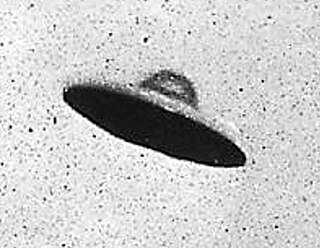
The Passaic UFO photographs are a set of photographs purportedly taken in Passaic, New Jersey by George Stock on July 31, 1952. Allegedly depicting a domed flying saucer, the images were widely published in contemporary media. Ufologist Kevin D. Randle called the Passaic photos the "most spectacular" of the 1952 flap but characterized them as a hoax.

















